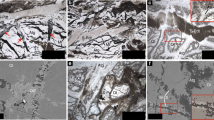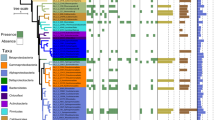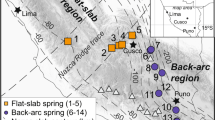Abstract
The subsurface is among Earth’s largest biomes, but the extent to which microbial communities vary across tectonic plate boundaries or interact with subduction-scale geological processes remains unknown. Here we compare bacterial community composition with deep-subsurface geochemistry from 21 hot springs across the Costa Rican convergent margin. We find that cation and anion compositions of the springs reflect the dip angle and position of the underlying tectonic structure and also correlate with the bacterial community. Co-occurring microbial cliques related to cultured chemolithoautotrophs that use the reverse tricarboxylic acid cycle (rTCA) as well as abundances of metagenomic rTCA genes correlate with concentrations of slab-volatilized carbon. This, combined with carbon isotope evidence, suggests that fixation of slab-derived CO2 into biomass may support a chemolithoautotrophy-based subsurface ecosystem. We calculate that this forearc subsurface biosphere could sequester 1.4 × 109 to 1.4 × 1010 mol of carbon per year, which would decrease estimates of the total carbon delivered to the mantle by 2 to 22%. Based on the observed correlations, we suggest that distribution and composition of the subsurface bacterial community are probably affected by deep tectonic processes across the Costa Rican convergent margin and that, by sequestering carbon volatilized during subduction, these chemolithoautotrophic communities could in turn impact the geosphere.
This is a preview of subscription content, access via your institution
Access options
Access Nature and 54 other Nature Portfolio journals
Get Nature+, our best-value online-access subscription
$29.99 / 30 days
cancel any time
Subscribe to this journal
Receive 12 print issues and online access
$259.00 per year
only $21.58 per issue
Buy this article
- Purchase on Springer Link
- Instant access to full article PDF
Prices may be subject to local taxes which are calculated during checkout




Similar content being viewed by others
Data availability
This Targeted Locus Study project has been deposited at DDBJ/EMBL/GenBank under the accession KEBJ00000000, with project ID PRJNA579365. The version described in this paper is the first version, KEBJ01000000. Metagenomic data are in the NCBI SRA with project ID PRJNA627197. The full environmental dataset is available at https://github.com/dgiovannelli/SubductCR_16S-diversity.git and released as a permanent version (v1.0) using Zenodo under https://doi.org/10.5281/zenodo.4553845. Source data are provided with this paper.
Code availability
A complete R script containing all the steps to reproduce our analysis, including the full environmental dataset, is available at https://github.com/dgiovannelli/SubductCR_16S-diversity.git and released as a permanent version (v1.0) using Zenodo under https://doi.org/10.5281/zenodo.4553845, https://doi.org/10.5281/zenodo.3483104.
References
Magnabosco, C. et al. The biomass and biodiversity of the continental subsurface. Nat. Geosci. 11, 707–717 (2018).
Merino, N. et al. Living at the extremes: extremophiles and the limits of life in a planetary context. Front. Microbiol. 10, 780 (2019).
Colman, D. R. et al. Geobiological feedbacks and the evolution of thermoacidophiles. ISME J. 12, 225–236 (2018).
Reveillaud, J. et al. Subseafloor microbial communities in hydrogen-rich vent fluids from hydrothermal systems along the Mid-Cayman Rise. Environ. Microbiol. 18, 1970–1987 (2016).
Lau, M. C. Y. et al. An oligotrophic deep-subsurface community dependent on syntrophy is dominated by sulfur-driven autotrophic denitrifiers. Proc. Natl Acad. Sci. USA 113, 7927–7936 (2016).
Momper, L., Jungbluth, S. P., Lee, M. D. & Amend, J. P. Energy and carbon metabolisms in a deep terrestrial subsurface fluid microbial community. ISME J. 11, 2319–2333 (2017).
Brazelton, W. J. et al. Metagenomic identification of active methanogens and methanotrophs in serpentinite springs of the Voltri Massif, Italy. PeerJ 5, e2945 (2017).
Havig, J. R., Raymond, J., Meyer-Dombard, D. R., Zolotova, N. & Shock, E. L. Merging isotopes and community genomics in a siliceous sinter-depositing hot spring. J. Geophys. Res. Biogeosci. 116, G01005 (2011).
Power, J. F. et al. Microbial biogeography of 925 geothermal springs in New Zealand. Nat. Commun. 9, 2876 (2018).
Lauber, C. L., Hamady, M., Knight, R. & Fierer, N. Pyrosequencing-based assessment of soil pH as a predictor of soil bacterial community structure at the continental scale. Appl. Environ. Microbiol. 75, 5111–5120 (2009).
Kelemen, P. B. & Manning, C. E. Reevaluating carbon fluxes in subduction zones, what goes down, mostly comes up. Proc. Natl Acad. Sci. USA 112, E3997–E4006 (2015).
Brovarone, A. V. et al. Subduction hides high-pressure sources of energy that may feed the deep subsurface biosphere. Nat. Commun. 11, 3880 (2020).
Plümper, O. et al. Subduction zone forearc serpentinites as incubators for deep microbial life. Proc. Natl Acad. Sci. USA 114, 4324–4329 (2017).
Syracuse, E. M. & Abers, G. A. Global compilation of variations in slab depth beneath arc volcanoes and implications. Geochem. Geophys. Geosyst. 7, Q05017 (2006).
Shaw, A. M., Hilton, D. R., Fischer, T. P., Walker, J. A. & Alvarado, G. E. Contrasting He–C relationships in Nicaragua and Costa Rica: insights into C cycling through subduction zones. Earth Planet. Sci. Lett. 214, 499–513 (2003).
Barry, P. H. et al. Forearc carbon sink reduces long-term volatile recycling into the mantle. Nature 568, 487–492 (2019).
Arce-Rodríguez, A. et al. Thermoplasmatales and sulfur-oxidizing bacteria dominate the microbial community at the surface water of a CO2-rich hydrothermal spring located in Tenorio Volcano National Park, Costa Rica. Extremophiles 23, 177–187 (2019).
Crespo-Medina, M. et al. Methane dynamics in a tropical serpentinizing environment: the Santa Elena ophiolite, Costa Rica. Front. Microbiol. 8, 916 (2017).
Probst, A. J. & Moissl-Eichinger, C. “Altiarchaeales”: uncultivated Archaea from the subsurface. Life https://doi.org/10.3390/life5021381 (2015).
Giggenbach, W. F. Geothermal solute equilibria, derivation of Na-K-Mg-Ca geoindicators. Geochim. Cosmochim. Acta 52, 2749–2765 (1988).
Giggenbach, W. F. & Soto, R. C. Isotopic and chemical composition of water and steam discharges from volcanic–magmatic–hydrothermal systems of the Guanacaste Geothermal Province, Costa Rica. Appl. Geochem. 7, 309–332 (1992).
Rodríguez, A. & van Bergen, M. J. Superficial alteration mineralogy in active volcanic systems: an example of Poás volcano, Costa Rica. J. Volcanol. Geotherm. Res. 346, 54–80 (2017).
Chan, C. S., Fakra, S. C., Emerson, D., Fleming, E. J. & Edwards, K. J. Lithotrophic iron-oxidizing bacteria produce organic stalks to control mineral growth: implications for biosignature formation. ISME J. 5, 717–727 (2011).
Lücke, O. H. & Arroyo, I. G. Density structure and geometry of the Costa Rican subduction zone from 3-D gravity modeling and local earthquake data. Solid Earth 6, 1169–1183 (2015).
Protti, M., Gündel, F. & McNally, K. The geometry of the Wadati–Benioff zone under southern Central America and its tectonic significance: results from a high-resolution local seismographic network. Phys. Earth Planet. Inter. 84, 271–287 (1994).
de Moor, J. M. et al. A new sulfur and carbon degassing inventory for the Southern Central American Volcanic Arc: the importance of accurate time-series data sets and possible tectonic processes responsible for temporal variations in arc-scale volatile emissions: new volatile budget for Central America. Geochem. Geophys. Geosyst. 18, 4437–4468 (2017).
Delgado-Baquerizo, M. et al. A global atlas of the dominant bacteria found in soil. Science 359, 320–325 (2018).
Kim, M. S., Jo, S. K., Roh, S. W. & Bae, J. W. Alishewanella agri sp. nov., isolated from landfill soil. Int. J. Syst. Evol. Microbiol. 60, 2199–2203 (2010).
Chen, W. M. et al. Aquabacterium limnoticum sp. nov., isolated from a freshwater spring. Int. J. Syst. Evol. Microbiol. 62, 698–704 (2012).
Garrity, G. M. & Bell, J. A. Bergey’s Manual of Systematics of Archaea and Bacteria (Bergey’s Manual Trust, 2015).
Hayashi, N. R., Ishida, T., Yokota, A., Kodama, T. & Igarashi, Y. Hydrogenophilus thermoluteolus gen. nov., sp. nov., a thermophilic, facultatively chemolithoautotrophic, hydrogen-oxidizing bacterium. Int. J. Syst. Evol. Microbiol. 49, 783–786 (1999).
Berg, I. A. et al. Autotrophic carbon fixation in archaea. Nat. Rev. Microbiol. 8, 447–460 (2010).
Giovannelli, D. et al. Insight into the evolution of microbial metabolism from the deep-branching bacterium, Thermovibrio ammonificans. eLife 6, e18990 (2017).
Yokochi, R. et al. Noble gas radionuclides in Yellowstone geothermal gas emissions: a reconnaissance. Chem. Geol. 339, 43–51 (2013).
Harris, R. N. & Wang, K. Thermal models of the Middle America Trench at the Nicoya Peninsula, Costa Rica. Geophys. Res. Lett. 29, 6-1–6-4 (2010).
Jelen, B. I., Giovannelli, D. & Falkowski, P. G. The role of microbial electron transfer in the coevolution of the biosphere and geosphere. Annu. Rev. Microbiol. 70, 45–62 (2016).
Falkowski, P. G., Fenchel, T. & Delong, E. F. The microbial engines that drive Earth’s biogeochemical cycles. Science 320, 1034–1039 (2008).
Tassi, F. et al. The geothermal resource in the Guanacaste region (Costa Rica): new hints from the geochemistry of naturally discharging fluids. Front. Earth Sci. 6, 69 (2018).
Tassi, F., Vaselli, O., Barboza, V., Fernandez, E. & Duarte, E. Fluid geochemistry and seismic activity in the period 1998–2002 at Turrialba Volcano (Costa Rica). Ann. Geophys. 47, 4 (2004).
Barry, P. H. et al. Helium, inorganic and organic carbon isotopes of fluids and gases across the Costa Rica convergent margin. Sci. Data https://doi.org/10.1038/s41597-019-0302-4 (2019).
Vetriani, C., Jannasch, H. W., MacGregor, B. J., Stahl, D. A. & Reysenbach, A.-L. Population structure and phylogenetic characterization of marine benthic archaea in deep-sea sediments. Appl. Environ. Microbiol. 65, 4375–4384 (1999).
Wright, J. J., Lee, S., Zaikova, E., Walsh, D. A. & Hallam, S. J. DNA extraction from 0.22 μm Sterivex filters and cesium chloride density gradient centrifugation. JOVE https://doi.org/10.3791/1352 (2009).
Teare, J. M. et al. Measurement of nucleic acid concentrations using the DyNA QuantTM and the GeneQuantTM. Biotechniques 22, 1170–1174 (1997).
Simbolo, M. et al. DNA qualification workflow for next generation sequencing of histopathological samples. PLoS ONE 8, e62692 (2013).
Giovannelli, D. et al. Diversity and distribution of prokaryotes within a shallow-water pockmark field. Front. Microbiol. 7, 941 (2016).
Huse, S. M. et al. VAMPS: a website for visualization and analysis of microbial population structures. BMC Bioinformatics 15, 41 (2014).
Huse, S. M. et al. Comparison of brush and biopsy sampling methods of the ileal pouch for assessment of mucosa-associated microbiota of human subjects. Microbiome 2, 5 (2014).
Schloss, P. D. et al. Introducing mothur: open-source, platform-independent, community-supported software for describing and comparing microbial communities. Appl. Environ. Microbiol. 75, 7537–7541 (2009).
Quast, C. et al. The SILVA ribosomal RNA gene database project: improved data processing and web-based tools. Nucleic Acids Res. 41, D590–D596 (2012).
Bolger, A. M., Lohse, M. & Usadel, B. Trimmomatic: a flexible trimmer for Illumina sequence data. Bioinformatics 30, 2114–2120 (2014).
Zhu, C. et al. Functional sequencing read annotation for high precision microbiome analysis. Nucleic Acids Res. 46, e23 (2018).
R Core Team, R: A Language and Environment for Statistical Computing (R Foundation for Statistical Computing, 2013).
McMurdie, P. J. & Holmes, S. phyloseq: an R package for reproducible interactive analysis and graphics of microbiome census data. PLoS ONE 8, e61217 (2013).
vegan (CRAN, 2019).
Hamilton, N. E. & Ferry, M. ggtern: ternary diagrams using ggplot2. J. Stat. Softw. 87, 1–17 (2018).
Stekhoven, D. J. & Buhlmann, P. MissForest—non-parametric missing value imputation for mixed-type data. Bioinformatics 28, 112–118 (2012).
Genuer, R., Poggi, J.-M. & Tuleau-Malot, C. VSURF: an R package for variable selection using random forests. R J. 7, 1–19 (2015).
Wickham, H. ggplot2: Elegant Graphics for Data Analysis (Springer, 2009).
Sheik, C. S. et al. Identification and removal of contaminant sequences from ribosomal gene databases: lessons from the Census of Deep Life. Front. Microbiol. 9, 840 (2018).
Sugimori, K. et al. Microbial life in the acid lake and hot springs of Poas Volcano, Costa Rica. In Proc. Colima Volcano International Meeting (2002).
Mcmurdie, P. J. & Holmes, S. Waste not, want not: why rarefying microbiome data is inadmissible. PLoS Comput. Biol. 10, e1003531 (2014).
Weiss, S. et al. Normalization and microbial differential abundance strategies depend upon data characteristics. Microbiome 5, 27 (2017).
Giovannelli, D. et al. Large-scale distribution and activity of prokaryotes in deep-sea surface sediments of the Mediterranean Sea and the adjacent Atlantic Ocean. PLoS ONE 8, e72996 (2013).
Holm, S. A simple sequentially rejective multiple test procedure. Scand. J. Stat. 6, 65–70 (1979).
Schruben, P. G. Geology and Resource Assessment of Costa Rica DDS-19-R (USGS, 1987).
Friedman, J. & Alm, E. J. Inferring correlation networks from genomic survey data. PLoS Comput. Biol. 8, e1002687 (2012).
Kurtz, Z. D. et al. Sparse and compositionally robust inference of microbial ecological networks. PLoS Comput. Biol. 11, e1004226 (2015).
Schwager, E., Mallick, H., Ventz, S. & Huttenhower, C. A Bayesian method for detecting pairwise associations in compositional data. PLoS Comput. Biol. 13, e1005852 (2017).
Zar, J. H. Significance testing of the spearman rank correlation coefficient. J. Am. Stat. Assoc. 67, 578–580 (1972).
Csardi, G. & Nepusz, T. The igraph software package for complex network research. InterJournal 1695, 1–9 (2006).
Braun, S. et al. Microbial turnover times in the deep seabed studied by amino acid racemization modelling. Sci. Rep. 7, 5680 (2017).
Whitman, W. B., Coleman, D. C. & Wiebe, W. J. Prokaryotes: the unseen majority. Proc. Natl Acad. Sci. USA 95, 6578–6583 (1998).
McMahon, S. & Parnell, J. Weighing the deep continental biosphere. FEMS Microbiol. Ecol. 87, 113–120 (2013).
Acknowledgements
This work is part of the Biology Meets Subduction project, a collaboration of 46 researchers from 19 institutions from 9 nationalities. We thank P. Barcala Dominguez for assistance with figure illustrations, and T. Hoehler for advice. Principal support came from the Alfred P. Sloan Foundation and the Deep Carbon Observatory (G-2016-7206) to P.H.B., J.M.d.M, D.G. and K.G.L., with DNA sequencing from the Census of Deep Life. Additional support came from NSF OCE-1431598, NASA Exobiology NNX16AL59G and Simons Foundation 404586 to K.G.L., NSF 1144559 to P.H.B., NSF 1850699 to J.M.d.M., NSF MCB 15–17567 to D.G. and C.V., ELSI Origins Network (EON) Research Fellowship from the John Templeton Foundation to D.G., Deep Life Modeling and Visualization Fellowship from the Deep Carbon Observatory to D.G., FONDECYT Grant 11191138 (ANID Chile) to G.L.J., ENIGMA (NASA Astrobiology Institute cycle 8, 80NSSC18M0093) to D.G., S.M.M. and J.B, U.S. Department of Energy, Office of Science, Office of Biological and Environmental Research (DE-SC0020369) to A.D.S. and K.G.L., JSPS KAKENHI grants JP17K14412, JP17H06105 and JP17H02989 to M.N. and DEKOSIM grant BAP-08-11-DPT.2012K120880, financed by the Strategy and Budget Ministry of Turkey, to M.Y. The opinions expressed in this publication are those of the authors and do not necessarily reflect the views of the John Templeton Foundation.
Author information
Authors and Affiliations
Contributions
K.M.F. and K.G.L. wrote the original draft and performed initial data analyses. Conceptualization and funding acquisition were performed by P.H.B., J.M.d.M., D.G. and K.G.L. Formal analysis and visualization were performed by K.M.F. and D.G. Investigations and data acquisition were performed by K.M.F., M.Y., E.M., G.D., D.F., M.D.C., F.R., M.N., F.S., H.M., S.M.M., T.J.R., M.B., J.B., A.D.S. and D.G. Writing and editing of the final draft was performed by M.O.S., M.Y., M.N., C.V., C.R., G.L.J., H.M., T.J.R., M.M., J.B., J.M.d.M., P.H.B., A.D.S., D.G. and K.G.L.
Corresponding authors
Ethics declarations
Competing interests
The authors declare no competing interests.
Additional information
Peer review information Primary Handling Editor(s): Rebecca Neely. Nature Geoscience thanks Jan Amend and the other, anonymous, reviewer(s) for their contribution to the peer review of this work.
Publisher’s note Springer Nature remains neutral with regard to jurisdictional claims in published maps and institutional affiliations.
Supplementary information
Supplementary Information
Supplementary Tables 1–17 and Figures 1–12.
Source data
Source Data Fig. 1
Source data for Fig. 1.
Source Data Fig. 2
Source data for the NMDS and ternary plots appearing in Fig. 2.
Source Data Fig. 3
Source data for the network analysis and the correlation of the cliques appearing in Fig. 3.
Source Data Fig. 4
Source data for the network analysis and the correlation of the gene-cliques appearing in Fig. 4.
Rights and permissions
About this article
Cite this article
Fullerton, K.M., Schrenk, M.O., Yücel, M. et al. Effect of tectonic processes on biosphere–geosphere feedbacks across a convergent margin. Nat. Geosci. 14, 301–306 (2021). https://doi.org/10.1038/s41561-021-00725-0
Received:
Accepted:
Published:
Issue Date:
DOI: https://doi.org/10.1038/s41561-021-00725-0
This article is cited by
-
Methane-hydrogen-rich fluid migration may trigger seismic failure in subduction zones at forearc depths
Nature Communications (2024)
-
Tectonic settings influence the geochemical and microbial diversity of Peru hot springs
Communications Earth & Environment (2023)
-
Chemolithoautotroph distributions across the subsurface of a convergent margin
The ISME Journal (2023)
-
Earthquake-enhanced dissolved carbon cycles in ultra-deep ocean sediments
Nature Communications (2023)
-
Targeting the gut and tumor microbiota in cancer
Nature Medicine (2022)



